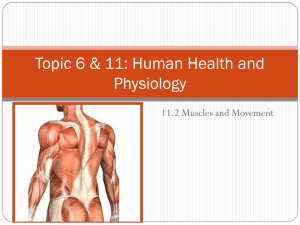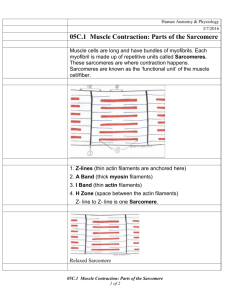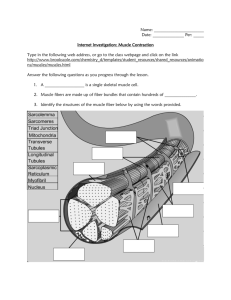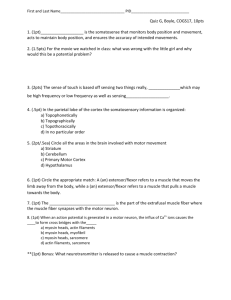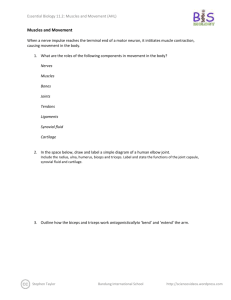HL Topic 11.2 Muscles
advertisement
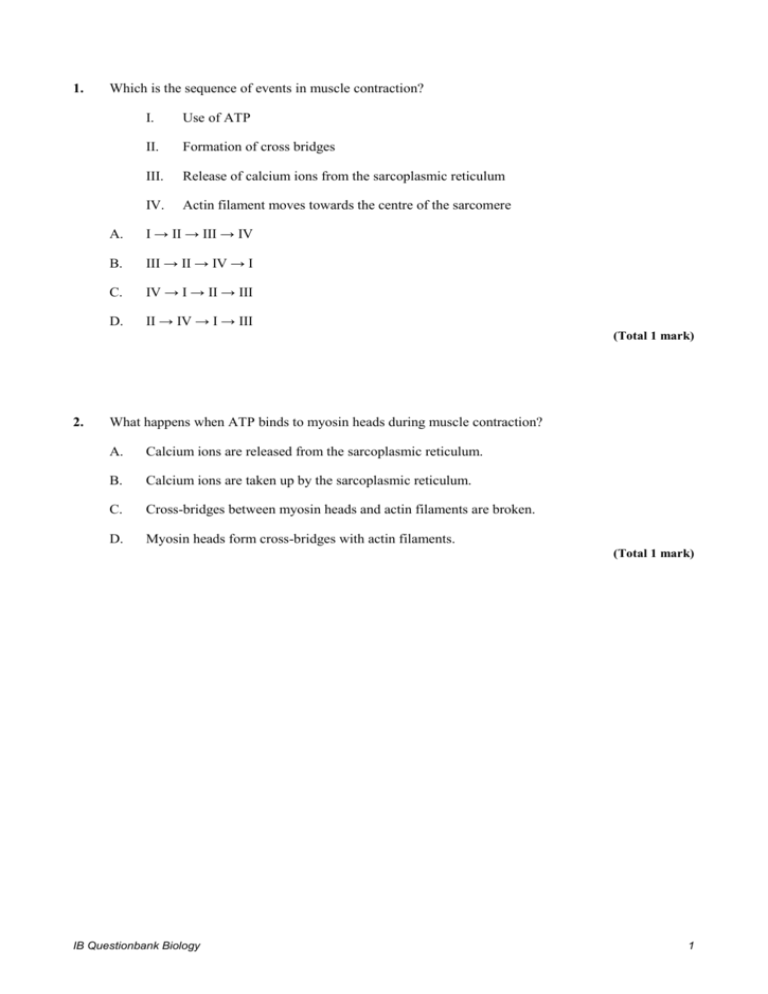
1. Which is the sequence of events in muscle contraction? I. Use of ATP II. Formation of cross bridges III. Release of calcium ions from the sarcoplasmic reticulum IV. Actin filament moves towards the centre of the sarcomere A. I → II → III → IV B. III → II → IV → I C. IV → I → II → III D. II → IV → I → III (Total 1 mark) 2. What happens when ATP binds to myosin heads during muscle contraction? A. Calcium ions are released from the sarcoplasmic reticulum. B. Calcium ions are taken up by the sarcoplasmic reticulum. C. Cross-bridges between myosin heads and actin filaments are broken. D. Myosin heads form cross-bridges with actin filaments. (Total 1 mark) IB Questionbank Biology 1 3. What is indicated by the letters X, Y and Z? X Y Z A. sarcomere myosin filaments actin filaments B. sarcomere actin filaments myosin filaments C. dark band myosin filaments actin filaments D. dark band actin filaments myosin filaments (Total 1 mark) IB Questionbank Biology 2 4. What does label X indicate? A. Sarcolemma B. Sarcomere C. Sarcoplasmic reticulum D. Endoplasmic reticulum (Total 1 mark) 5. What structure within muscle tissue is surround by membrane and has multiple nuclei? A. Muscle bundle B. Muscle fibre C. Myofibril D. Sarcomere (Total 1 mark) IB Questionbank Biology 3 6. What happens during muscle contraction? A. The number of light bands is reduced. B. The width of the dark bands is reduced. C. The lengths of the sarcomeres are reduced. D. Actin and myosin filaments coil up. (Total 1 mark) 7. (a) Draw a labelled diagram of a sarcomere. (3) IB Questionbank Biology 4 (b) Explain the role of calcium ions in muscle contraction. ...................................................................................................................................... ...................................................................................................................................... ...................................................................................................................................... ...................................................................................................................................... ...................................................................................................................................... ...................................................................................................................................... (2) (Total 5 marks) 8. (a) The diagram below shows an elbow joint. (i) On the diagram, label a pair of antagonistic muscles. (1) IB Questionbank Biology 5 (ii) State the function of the structure labelled A. ........................................................................................................................... ........................................................................................................................... ........................................................................................................................... (1) (b) Explain the role of ATP in the contraction of skeletal muscle. ...................................................................................................................................... ...................................................................................................................................... ...................................................................................................................................... ...................................................................................................................................... ...................................................................................................................................... ...................................................................................................................................... ...................................................................................................................................... (3) (Total 5 marks) IB Questionbank Biology 6 9. (a) Label the parts of the following micrograph of the striated muscle. [Coen A.C. Ottenheijm, Leo M.A. Heunks and Richard P.N. Dekhuijzen(2008) Diaphragm adaptations in patients with COPD. _Respiratory Research_, 9(12), doi:10.1186/1465-9921-9-12. © 2008 Ottenheijm _et al._; licensee BioMed Central Ltd.] I. .................................................................................................................................. II. ................................................................................................................................. III. ................................................................................................................................ (3) (b) Outline the effect of training on vital capacity. ...................................................................................................................................... ...................................................................................................................................... (1) (Total 4 marks) IB Questionbank Biology 7 10. (a) Outline the effects of moderate-intensity exercise and high-intensity exercise on muscle fibres and heart rate. ...................................................................................................................................... ...................................................................................................................................... ...................................................................................................................................... ...................................................................................................................................... ...................................................................................................................................... (2) (b) Evaluate the risks and benefits of using blood transfusions to improve performance in sports. ...................................................................................................................................... ...................................................................................................................................... ...................................................................................................................................... ...................................................................................................................................... ...................................................................................................................................... ...................................................................................................................................... ...................................................................................................................................... ...................................................................................................................................... (4) (Total 6 marks) 11. (a) Label the parts of the sarcomere indicated below. (2) IB Questionbank Biology 8 (b) (i) Distinguish between fast muscle fibres and slow muscle fibres. ........................................................................................................................... ........................................................................................................................... ........................................................................................................................... (2) (ii) Discuss the need for warm-up routines. ........................................................................................................................... ........................................................................................................................... ........................................................................................................................... ........................................................................................................................... ........................................................................................................................... (3) (Total 7 marks) 12. (a) Draw a labelled diagram to show the structure of a skeletal muscle sarcomere. (3) IB Questionbank Biology 9 (b) Outline the role of myoglobin in muscle fibres. ...................................................................................................................................... ...................................................................................................................................... ...................................................................................................................................... ...................................................................................................................................... ...................................................................................................................................... ...................................................................................................................................... (2) (Total 5 marks) 13. Up to two additional marks are available for the construction of your answers. (2) (a) Draw a labelled diagram to show the structure of a sarcomere. (4) (b) Outline how skeletal muscle contracts. (5) (c) Explain how nerve impulses are transmitted along and between neurons. (9) (Total 20 marks) IB Questionbank Biology 10 14. Marine biologists tested the possible adaptations in skeletal muscles to maintain aerobic metabolism under hypoxic (low oxygen) conditions. Samples were collected from swimming and non-swimming muscles of the following Pinnipeds: sea lions (Eumetopias jubatus), fur seals (Callorhinus ursinus) and harbour seals (Phoca vitulina). The sampled muscles were measured for concentration of mitochondria. The activity of β-hydroxyacyl-CoA dehydrogenase (HAD), an enzyme used for the oxidation of fatty acids used in respiration, was assessed at different concentrations of mitochondria. [Source: S B Kanatous et al. 1999. “High aerobic capacities in the skeletal muscles of pinnipeds: adaptations to diving hypoxia.” Journal of American Physiological Society. Vol 8750. Pp 1247–1256. © Am Physiol Soc, used with permission] IB Questionbank Biology 11 (a) State the general relationship between concentration of mitochondria and the activity of HAD. ...................................................................................................................................... (1) (b) Distinguish between the non-swimming muscles of sea lions and the non-swimming muscles of fur seals. ...................................................................................................................................... ...................................................................................................................................... ...................................................................................................................................... ...................................................................................................................................... (2) (c) Compare swimming muscles and non-swimming muscles in Pinnipeds. ...................................................................................................................................... ...................................................................................................................................... ...................................................................................................................................... ...................................................................................................................................... (2) IB Questionbank Biology 12 (d) Studies of harbour seals led to the hypothesis that stores of fats (triglycerides) may play an important role in ATP production, especially during diving. Discuss this hypothesis using the data provided. ...................................................................................................................................... ...................................................................................................................................... ...................................................................................................................................... ...................................................................................................................................... ...................................................................................................................................... ...................................................................................................................................... ...................................................................................................................................... ...................................................................................................................................... (3) (Total 8 marks) IB Questionbank Biology 13
